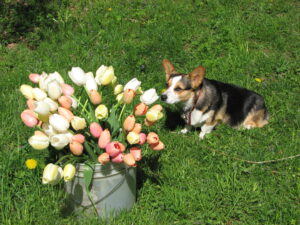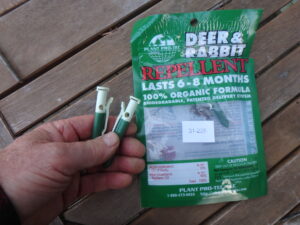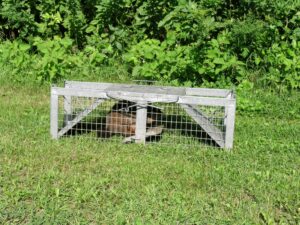Oh Dear: Dealing with Deer, Woodchucks and More
I’ve never had much trouble with deer eating my vegetables or flowers. I know gardeners who have wept when they saw that their lovely tulips had been munched by deer just when they were achieving perfection. But I’ve always had dogs, and dogs leave scents that are scary to deer. My little corgi, Daphne, leaves messages saying to the deer, “I am actually a wolf.” And they believe her.
The best repellent I’ve found are called garlic clips that I get from Gardeners Supply. These are little devices that hold garlic oil and clip onto branches. You must first puncture a seal with a little tool that comes with it. They’ve worked all winter for me on tasty shrubs.
I saw an alternative method once. The gardener bought lengths of plastic pipe, the kind used by plumbers. He cut it into 12- to 24- inch sections and buried them in the ground every 10 feet. He used either a crow bar or an auger to make holes big enough for the pipe.
Trap size is important: a woodchuck or large animal needs a trap with a 12-inch square opening that is about 36 inches long. Squirrels do fine in something with a 6-inch square door that is 18 inches long.
What to Do About Those Wile Woodchucks!
Woodchucks, alas, are out and about. Fortunately I don’t have lettuce or green beans growing in my garden yet, as I saw my first one lounging in the sun on April 11 in a neighbor’s field. It was looking relaxed and happy. If you’ve have had woodchucks in the past, now is the time to take action to remove or repel them – before they have a litter of babies to join in the carnage of our gardens. They know danger and are willing and able to relocate – at least as far away as the next-door neighbor’s house.
When my corgi, Daphne, was a youngster I was working in a garden in Woodstock, Vermont when I saw a woodchuck sunning by my client’s barn. I let her out of the car and told her to “Go get it.” That was a new command, but she got the idea immediately and took off at a dead run.
The woodchuck was not paying attention – and barely made it down its hole before Deadly Daphne got there. Daffy tried to go down the hole, and got her front end in, but then perhaps a turn in the tunnel blocked her way. But I could hear the terrified woodchuck squealing inside the hole. My client reported that she never saw a woodchuck again. Not that summer, not the next. Perhaps, like 1930’s hoboes, the woodchuck left an “X” on the barn to warn the next marauding woodchuck that the place was not safe.
Woodchucks have 2 to 6 babies which are usually born in April or May. Females are generally have one litter in their second summer, but occasionally they will have young their first year of life. It is important to encourage woodchucks to relocate now, before they have babies. Since I have snow on the ground and little for them to eat, I am confident they haven’t had babies yet. Farther south? Who knows?
If you’ve had woodchucks in the past, you should check to see if their dens are active. Put strips of newspaper or stuff some hay in the openings, loosely plugging them, and check them daily. Each den will have 2 to 5 openings, each hole about 8 inches across. The back door(s) may be well hidden. I once saw a woodchuck disappear into a stone wall, but that may have been a temporary move – my dog was chasing it.
Once a mother woodchuck has had babies, it will be hard or impossible to get her to leave her den. For humane reasons you should defer relocating woodchucks until 3 weeks after the babies are born.
So how do you evict a woodchuck? According to the Humane Society Website, You can scare it away by partially digging out the opening and cutting away any vegetation near it. Or you can put urine-saturated cat litter down the hole, and then shovel some dirt in to loosely seal the burrow. They also suggest reflective Mylar strips hanging near ground level in the garden.
To keep woodchucks from returning to their burrow, close off the entrances with wire mesh screening with openings no bigger than 3 inches across. Cut a 3-foot square and stuff it into the entrance. Woodchucks have been known to return to a good home up to several years later.
What other options do you have? You can fence your garden with 3 to 4 feet of metal fencing such as chicken wire. Leave the top 18 inches floppy so that even an ambitious ground hog will find it hard to get over the top. Bury the bottom in the soil, and pin it down with landscape staples.

Only use a Hav-a-Hart trap to relocate a woodchuck if all attempts to get it to relocate have failed
If you’ve tried everything else and want to use a Hav-a-Hart trap to catch one, bait the trap with something fruity and fragrant. Sliced apples or watermelon work, though I know someone who used green beans. It makes sense to use something not available outside the trap. And place the trap along the pathway from the den to the garden.
According to Vermont naturalist Ted Levin, catching a rodent (woodchucks included) in a Hav-a-Hart trap and moving it away is generally a death sentence. When they land in new territory they are likely to fall prey to a fox, coyote or other predator. Food is uncertain, too, especially if yours is dependent on your garden produce. So please, only use Hav-a-Hart traps as a last resort. In some communities trapping wild animals is prohibited, so check with your town clerk or animal warden before investing in a trap.
I happen to like woodchucks. They remind me of fuzzy little bears. I love seeing them standing up and looking around like miniature grizzlies. I just don’t want them on my land. So if one turns up, I’ll try to scare it away. Daphne can earn her kibbles!
Read Henry’s blog posts at https://dailyuv.com/







